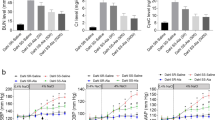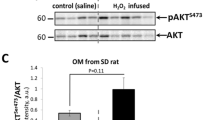Abstract
Background
Renal interstitial inflammation and oxidative stress are invariably present and play a key role in the pathogenesis of hypertension in experimental animals. Mitochondria are the major source of reactive oxygen species (ROS). ROS generated in the mitochondria are normally contained by the mitochondrial antioxidant system including manganese superoxide dismutase (MnSOD). We have previously shown that a high salt diet causes hypertension in MnSOD-deficient (MnSOD+/−) mice but not in wild-type mice. The present study was undertaken to determine the effect of a high salt diet on oxidative and inflammatory pathways in the kidneys of MnSOD+/− mice compared to the wild-type mice.
Methods
Wild-type (MnSOD+/+) and MnSOD+/− mice were randomized to receive a regular or a high salt diet for 4 months. Tail arterial pressure was measured and timed urine collection was obtained. The animals were then euthanized and the kidneys were harvested and processed for histological examination and Western blot analyses.
Results
In confirmation of our earlier study, a high salt diet resulted in a significant rise in arterial pressure and urinary albumin excretion in MnSOD+/− mice. This was accompanied by upregulation of NAD(P)H oxidase subunits, activation of nuclear factor kappa B, and elevation of PAI-1, iNOS, oxidized LDL receptor, and CD36 in the kidneys of the MnSOD+/− mice fed the high salt diet. In contrast, consumption of a high salt diet did not significantly alter blood pressure, urine protein excretion, or the measured oxidative and inflammatory mediators in the wild-type mice.
Conclusion
Salt-induced hypertension in MnSOD+/− mice is associated with activation of intra-renal inflammatory and ROS generating pathways.





Similar content being viewed by others
References
Esposito LA, Melov S, Panov A, et al. Mitochondrial disease in mouse results in increased oxidative stress. Proc Natl Acad Sci USA. 1999;96(9):4820–5.
Kokoszka JE, Coskun P, Esposito LA, et al. Increased mitochondrial oxidative stress in the Sod2 (+/−) mouse results in the age-related decline of mitochondrial function culminating in increased apoptosis. Proc Natl Acad Sci USA. 2001;98(5):2278–83.
Rodriguez-Iturbe B, Sepassi L, Quiroz Y, et al. Association of mitochondrial SOD deficiency with salt-sensitive hypertension and accelerated renal senescence. J Appl Physiol. 2007;102(1):255–60.
Cai H, Harrison DG. Endothelial dysfunction in cardiovascular diseases: the role of oxidant stress. Circ Res. 2000;87(10):840–4.
Romero JC, Reckelhoff JF. State-of-the-Art lecture. Role of angiotensin and oxidative stress in essential hypertension. Hypertension. 1999;34(4):943–9.
Franco M, Martínez F, Quiroz Y, et al. Renal angiotensin II concentration and interstitial infiltration of immune cells are correlated with blood pressure levels in salt-sensitive hypertension. Am J Physiol Regul Integr Comp Physiol. 2007;293(1):R251–6.
Franco M, Sanchez-Lozada LG, Bautista R, et al. Pathophysiology of salt-sensitive hypertension: a new scope of an old problem. Blood Purif. 2008;26(1):45–8.
Rodriguez-Iturbe B, Johnson RJ. The role of renal microvascular disease and interstitial inflammation in salt-sensitive hypertension. Hypertens Res. 2010;33(10):975–80.
Melov S, Coskun P, Patel M, et al. Mitochondrial disease in superoxide dismutase 2 mutant mice. Proc Natl Acad Sci USA. 1999;96(3):846–51.
Vaziri ND, Ni Z, Wang XQ, et al. Downregulation of nitric oxide synthase in chronic renal insufficiency: role of excess PTH. Am J Physiol. 1998;274(4):F642–9.
Kim HJ, Vaziri ND. Sterol regulatory element-binding proteins, liver X receptor, ABCA1 transporter, CD36, scavenger receptors A1 and B1 in nephrotic kidney. Am J Nephrol. 2009;29(6):607–14.
Kim HJ, Moradi H, Yuan J, et al. Renal mass reduction results in accumulation of lipids and dysregulation of lipid regulatory proteins in the remnant kidney. Am J Physiol Ren Physiol. 2009;296(6):F1297–306.
Alvarez V, Quiroz Y, Nava M, et al. Overload proteinuria is followed by salt-sensitive hypertension caused by renal infiltration of immune cells. Am J Physiol Ren Physiol. 2002;283(5):F1132–41.
Quiroz Y, Ferrebuz A, Romero F, et al. Melatonin ameliorates oxidative stress, inflammation, proteinuria, and progression of renal damage in rats with renal mass reduction. Am J Physiol Ren Physiol. 2008;294(2):F336–44.
Montezano AC, Touyz RM. Oxidative stress, Noxs, and hypertension: experimental evidence and clinical controversies. Ann Med. 2012;44:S2–16.
Luo Z, Teerlink T, Griendling K, et al. Angiotensin II and NADPH oxidase increase ADMA in vascular smooth muscle cells. Hypertension. 2010;56(3):498–504.
Nishi EE, Oliveira-Sales EB, Bergamaschi CT, et al. Chronic antioxidant treatment improves arterial renovascular hypertension and oxidative stress markers in the kidney in Wistar rats. Am J Hypertens. 2010;23(5):473–80.
Tian N, Moore RS, Phillips WE, et al. NADPH oxidase contributes to renal damage and dysfunction in Dahl salt-sensitive hypertension. Am J Physiol Regul Integr Comp Physiol. 2008;295(6):R1858–65.
Vaziri ND, Rodríguez-Iturbe B. Mechanisms of disease: oxidative stress and inflammation in the pathogenesis of hypertension. Nat Clin Pract Nephrol. 2006;2(10):582–93.
Förstermann U, Münzel T. Endothelial nitric oxide synthase in vascular disease: from marvel to menace. Circulation. 2006;113(13):1708–14.
Sydow K, Münzel T. ADMA and oxidative stress. Atheroscler Suppl. 2003;4(4):41–51.
Ungvari Z, Sun D, Huang A, et al. Role of endothelial [Ca2+]i in activation of eNOS in pressurized arterioles by agonists and wall shear stress. Am J Physiol Heart Circ Physiol. 2001;281(2):H606–12.
Vaziri ND, Ni Z. Expression of NOX-I, gp91phox, p47phox and P67phox in the aorta segments above and below coarctation. Biochim Biophys Acta. 2005;1723(1–3):321–7.
Sindhu RK, Roberts CK, Ehdaie A, et al. Effects of aortic coarctation on aortic antioxidant enzymes and NADPH oxidase protein expression. Life Sci. 2005;76(8):945–53.
Barton CH, Ni Z, Vaziri ND. Enhanced nitric oxide inactivation in aortic coarctation-induced hypertension. Kidney Int. 2001;60(3):1083–7.
Vaziri ND, Wang XQ, Oveisi F, et al. Induction of oxidative stress by glutathione depletion causes severe hypertension in normal rats. Hypertension. 2000;36(1):142–6.
Rodríguez-Iturbe B, Franco M, Tapia E, et al. Renal inflammation, autoimmunity and salt-sensitive hypertension. Clin Exp Pharmacol Physiol. 2012;39:96–103.
Guzik TJ, Hoch NE, Brown KA, et al. Role of the T cell in the genesis of angiotensin II induced hypertension and vascular dysfunction. J Exp Med. 2007;204:2449–60.
Rodríguez-Iturbe B, Quiroz Y, Nava M, et al. Reduction of renal immune cell infiltration results in blood pressure control in genetically hypertensive rats. Am J Physiol Renal Physiol. 2002;282:F191–201.
Harrison DG, Guzik TJ, Lob HE, et al. Inflammation, immunity, and hypertension. Hypertension. 2011;57:132–40.
Dikalova AE, Bikineyeva AT, Budzyn K, et al. Therapeutic targeting of mitochondrial superoxide in hypertension. Circ Res. 2010;107(1):106–16.
Acknowledgments
The MnSOD-deficient mice were generously provided by Dr. Douglas C. Wallace.
Conflict of interest
The authors declare no conflicts of interest.
Author information
Authors and Affiliations
Corresponding author
About this article
Cite this article
Jin, K., Vaziri, N.D. Salt-sensitive hypertension in mitochondrial superoxide dismutase deficiency is associated with intra-renal oxidative stress and inflammation. Clin Exp Nephrol 18, 445–452 (2014). https://doi.org/10.1007/s10157-013-0851-3
Received:
Accepted:
Published:
Issue Date:
DOI: https://doi.org/10.1007/s10157-013-0851-3




